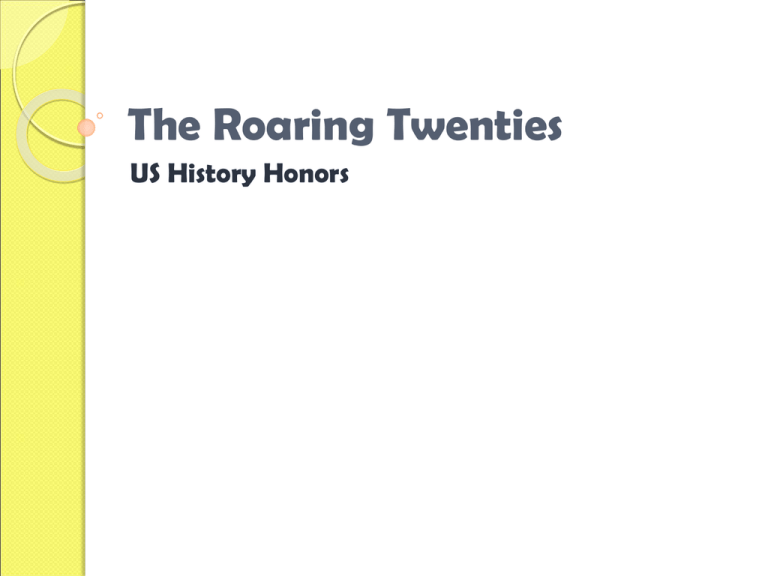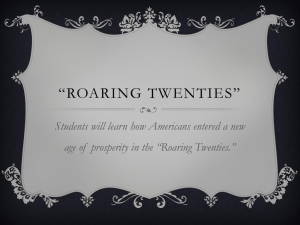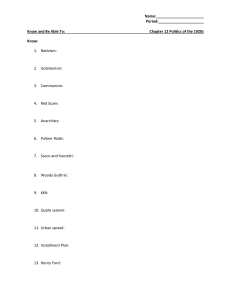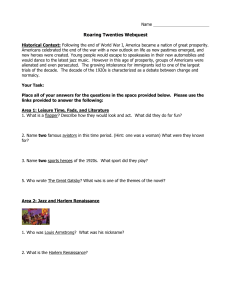The Roaring Twenties - University High School
advertisement

The Roaring Twenties US History Honors I. THE RED SCARE (1919-1920) A. The Red Scare Communism: economic & political system, single-party government ruled by a dictator and no private property 1919:Vladimir Lenin and the Bolsheviks set up Communist state in Russia US Communist Party forms; some Industrial Workers of the World (IWW) join A. The Red Scare Bombs mailed to government and businesses; people fear Red conspiracy Attorney General A. Mitchell Palmer takes action B. Palmer Raids Palmer and Hoover hunt down Communists, socialists and anarchists Anarchists oppose any form government Raids trample civil rights and fail to find evidence of conspiracy II. SACCO & VANZETTI TRIAL Sacco & Vanzetti Trial A. Sacco and Vanzetti Trial Red Scare feeds fear of foreigners, ruins reputations, and wrecks lives 1920: Sacco and Vanzetti (Italian immigrants) who were also anarchists were arrested… ◦ Charged with robbery and murder ◦ Trial does not prove guilt Jury finds them guilty; widespread protests in US and aboard Sacco and Vanzetti executed in 1927 III. NATIVISM & THE NEW KKK A. Nativism Nativists: fewer unskilled jobs available which means fewer immigrants needed Between 1919 and 1921 over a million foreigners entered the country B. The New KKK The most extreme expression of nativism in the 1920s was the resurgence of the Ku Klux Klan KKK opposes blacks, Catholics, Jews, immigrants, and unions Klan controls many states’ politics By 1925 the Klan had 5 million members IV. THE QUOTA SYSTEM A. The Quota System Quota System sets maximum number of immigrants that can enter the US from each country 1924: European arrivals cut to 2% of number of residents in 1890 Discriminates against southern and eastern Europeans Prohibits Japanese immigrants which will cause ill will between the US and Japan CHECK POINT The Red Scare, the National Origins Acts of the 1920s, and the verdict in the Sacco and Vanzetti trial are examples of negative American attitudes toward A. B. C. D. immigrants business leaders African Americans Labor union leaders Which characteristic of the 1920s is illustrated by the trial of Sacco and Vanzetti? A. B. C. D. hostility toward woman’s suffrage support for segregation opposition to separation of church and state intolerance toward immigrants During the 1920s, Congress passed a series of immigration laws that were primarily designed to A. B. C. D. increase immigration from Asia expand the workforce for the growing economy limit immigration from southern and eastern Europe prohibit immigration from Latin America The influence of nativism during the 1920s is best illustrated by the A. B. C. D. increase in the popularity of the automobile emergence of the flappers expansion of trusts and monopolies growth of the Ku Klux Klan A major goal of the immigration acts of the 1920s was to A. B. C. D. allow unlimited immigration from Southeast Asia assure equal numbers of immigrants from all nations favor wealthy and well-educated immigrants use quotas to limit immigration from southern and eastern Europe V. PROHIBITION EXPERIMENT A. The Prohibition Experiment 18th Amendment launches Prohibition Era ◦ Supported by religious groups, rural South & West Prohibition: illegal to produce, sell or transport alcohol Government does not budget enough money to enforce the law B. Defying the Law Prohibition did not stop people from drinking alcohol at home or in public In the cities it became fashionable to defy the law by going to speakeasies (bar or club) Bootleggers smuggle alcohol from surrounding countries (Canada) City police were paid to look the other way C. Organized Crime Prohibition contributes to organized crime in most major cities (NYC and Chicago) Al Capone controls Chicago liquor business by killing his competitors By mid-1920s only 19% support Prohibition 18th Amendment in force until 1933 It will be repealed by the 21st Amendment VI. THE SCOPES TRIAL A. American Fundamentalism Fundamentalism: movement based on literal interpretation of Bible Fundamentalists skeptical of some scientific discoveries and theories ◦ They reject the theory of evolution ◦ Believe all important knowledge can be found in Bible B. The Scopes Trial The entire nation followed the Scopes Trial both in the newspapers and on the radio 1925: Tennessee passes law making it a crime to teach evolution in schools American Civil Liberties Union backs John Scopes challenge of the law The debates evolution, role of science and religion in schools C. The Aftermath Scopes was found guilty but the conviction was later overturned on a technicality Laws banning the teaching of evolution remained on the books for years Darrow (Scope’s lawyer) had thoroughly discredited fundamentalism VII. WOMEN IN THE 1920’S A. Revolution in Morals Young men and women of the 1920s revolted against sexual taboos Some were influenced by the writings of Sigmund Freud The work of Margaret Sanger and other advocates of birth control achieved growing acceptance in the twenties B. Flappers Young women shocked their elders by wearing dresses hemmed at the knee ‘Bobbing’ their hair Smoking cigarettes Driving cars Taking office jobs before they married CHECK POINT During the 1920s, controversies concerning the Scopes trial, national Prohibition, and the behavior of “flappers” were all signs of disagreement over A. B. C. D. the return to normalcy traditional values and changing lifestyles causes of the Great Depression the benefits of new technology The failure of national Prohibition led to a public awareness that A. crime rates decline when the sale of alcoholic beverages is banned B. economic prosperity encourages social conformity C. unpopular laws are difficult to enforce D. geographic conditions affect law enforcement The national policy of Prohibition ended when the states A. B. C. D. strengthened food and drug laws legalized alcohol for medical purposes ratified the 21st amendment banned interstate shipment of alcoholic beverages In 1920, women gained the right to vote as a result of a A. B. C. D. presidential order Supreme Court decision national election constitutional amendment The Scopes trial of 1925 is an example of A. B. C. D. the effects of assimilation on American culture a clash between scientific ideas and religious beliefs an increase in violence in American society government intervention in racial conflicts National Prohibition, as authorized by the 18th amendment, stated that A. Americans must be 18 years old to purchase alcoholic beverages B. only imported alcoholic beverages would be sold C. alcoholic beverages could be sold only in government run stores D. the manufacture and sale of alcoholic beverages was banned Which event of the 1920s symbolized a conflict over cultural values? A. B. C. D. election of Herbert Hoover transatlantic flight of Charles Lindbergh Scopes trial stock market crash The Scopes trial of the 1920s dealt with a conflict between A. B. C. D. communism and capitalism Protestants and Catholics science and religion labor and management VIII. HARLEM RENAISSANCE A. Harlem Renaissance By 1930, almost 20% of African-Americans lived in the North Harlem became famous in the 1920s for its concentration of talented actors, artists, musicians and writers B. The Jazz Age High school and college youth expressed their rebellion against their elders’ culture by dancing to jazz music Jazz became a symbol of the “new” and “modern” culture of the cities CHECK POINT Langston Hughes and Duke Ellington are noted for their contributions to the cultural movement of the 1920s known as the A. B. C. D. Gospel of Wealth Lost Generation Harlem Renaissance Gilded Age “Public Ignores Prohibition Restrictions” “Evolution and Creation Debated in Scopes Trial” “Women Bring Change to the Industrial Workforce” What do headlines such as these from the 1920s illustrate? A. B. C. D. conflict between traditional and modern values trend toward mass consumption of consumer goods hostility of certain groups toward ethnic minorities debate over the role of government in the economy During the Harlem Renaissance of the 1920s, African American authors and artists used literature and art to A. B. C. D. end segregation of public facilities promote affirmative action programs celebrate the richness of their heritage urge voters to elect more African Americans to political office The changing image of women during the 1920s was symbolized by the A. B. C. D. passage of an equal pay act drafting of women into the army popularity of the flappers and their style of dress appointment of several women to President Coolidge’s cabinet The Harlem Renaissance promoted African American culture by A. increasing factory employment opportunities for minorities B. encouraging immigration from Africa C. focusing attention on artistic contributions D. bringing an end to legalized racial segregation Which pair of events illustrates an accurate cause and effect relationship? A. Sacco and Vanzetti trial – ratification of the woman suffrage amendment B. rebirth of the KKK – formation of the Populist Party C. Red Scare – demand for limits on immigration D. high food prices – start of the Great Depression The convictions of Sacco and Vanzetti in the 1920s most closely reflected the A. B. C. D. increase in nativist attitudes federal government’s war on crime corruption of political machines rise in labor unrest In the 1920s, both Langston Hughes and Duke Ellington made major contributions to A. B. C. D. economic growth educational reform the creative arts political leadership During the 1920s, the United States changed its immigration policy by passing new laws that A. provided incentives to attract more immigrants to factory jobs B. encouraged Chinese immigrants to enter the country C. allowed unrestricted immigration of war refugees from Vietnam D. established quotas that reduced the number of immigrants from certain countries What was a main result of national Prohibition during the 1920s? A. B. C. D. respect for the law decreased woman’s suffrage was restricted racial prejudice increased religious tolerance grew






